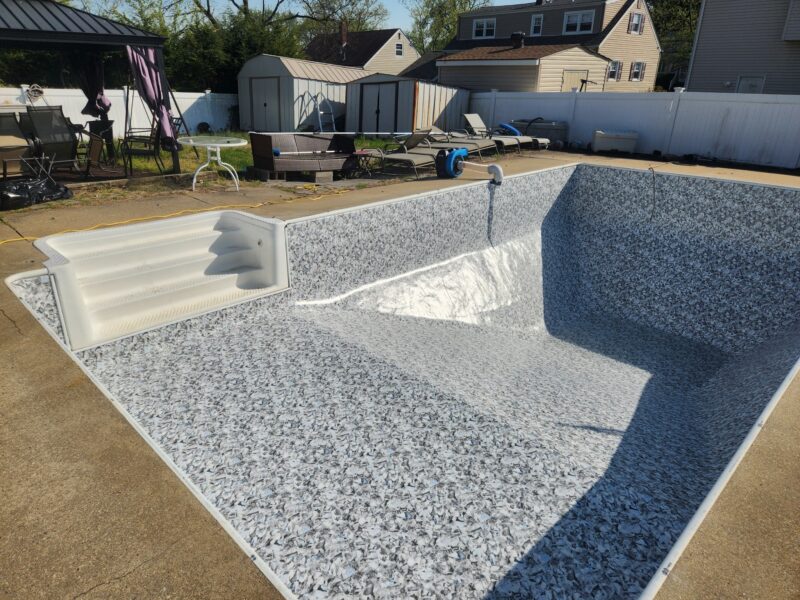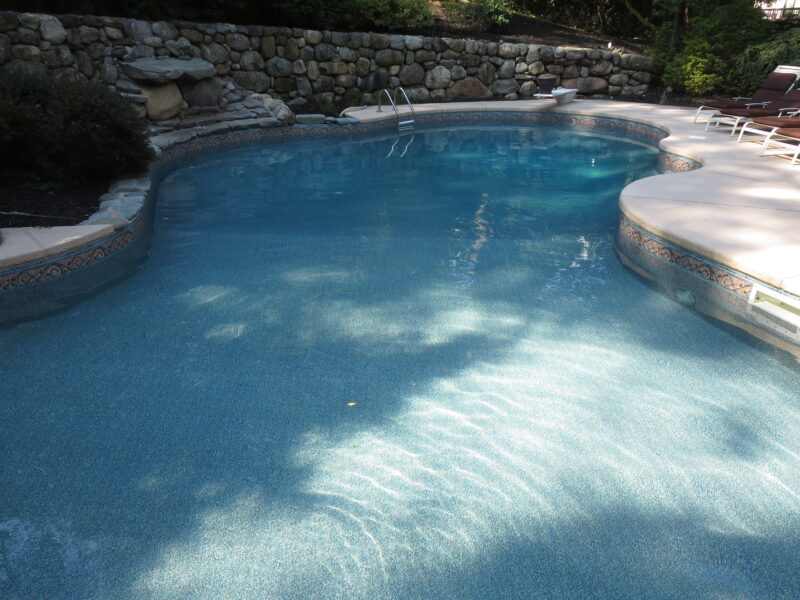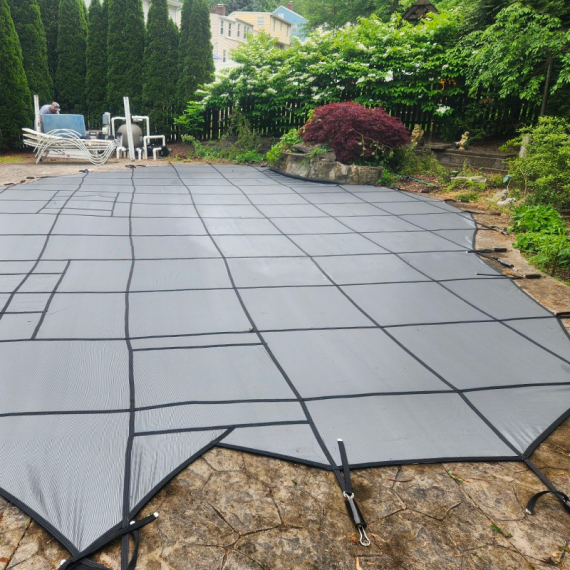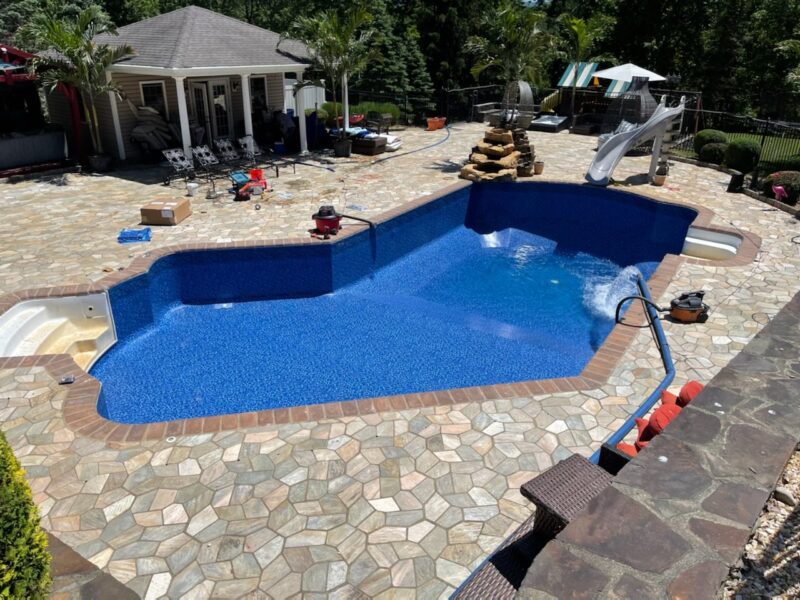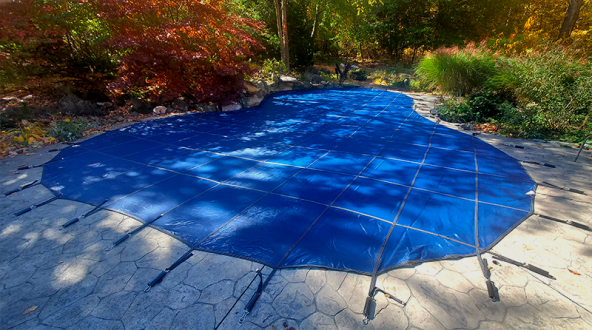How Much Does It Cost to Fill a Pool with Water (2025)?
$90-$2,000: that’s how much filling a pool with water tends to cost. The number is a rough estimate and depends on tons of factors. So, if you’re wondering, “How much does it cost to fill a pool?” you’ll want to read on to find all the nitty gritty details.
Homeowners and businesses: for more than 20 years, we’ve been helping people like you to find data-driven answers for your pool maintenance and manufacturing needs.
We know that the numbers are all over the board, which is why we created this helpful guide that looks at the cost of filling a pool with water.
If you’re looking for a breakdown of those costs, you’ve arrived at the right place. In this article, we’ll discuss:
- The factors that affect the cost of filling a swimming pool with water
- A cost breakdown of the price per gallon of water filled
- Common pool water delivery services, additions, and accessories to help with filling a pool
- Better pool water storage solutions with our Pool Bladder™
- Frequently asked questions (FAQ) about the cost of filling swimming pools with water
The average cost to fill a pool with water
| Pool water type | Cost per gallon of pool water |
| City water | $0.004-$0.01 |
| Well water | $0 (not including electricity for pool-related maintenance) |
| Water delivery services | $0.03-$0.10 |
Factors that figure into the cost to fill a pool
Water tends to be one of the largest costs for pool maintenance. On average, most people will spend about $20 to $500 each season to replace evaporation from a pool.
To replace an empty pool tends to cost much more. To determine the price to fill a pool, homeowners and businesses will want to keep in mind the following factors:
- The size of the pool
- The type of water being used in the pool
- Whether the pool needs a partial or full fill
- The region of the country where the pool is located
We’ll dive into each of these ideas in the following sections.
The size of a pool
Since the average pool holds about 17,000 gallons, filling the pool will cost about $68 to $170, that is, with a garden hose. If filling a pool with a water delivery service, expect to pay anywhere from $30 to $1,700, depending on the size of the pool.
In general, inground pools tend to cost more to fill than above-ground pools.
| The size of the pool | The number of gallons the pool holds | The average cost of the pool |
| Hot tubs | 300-500 gallons | $1-$50 |
| Compact swimming pools | 6,000-6,800 gallons | $24-$680 |
| Cocktail pools | 8,000-10,000 gallons | $32-$1,000 |
| Standard backyard pools | 12,000-13,500 gallons | $48-$1,300 |
| Lap pools | 16,000-20,000 gallons | $64-$2,000 |
| Diving pools | 23,000-28,000 gallons | $92-$2,800 |
Note: These prices are averages and may fluctuate with changes in the market.
The type of pool water used
Whether using local municipal water or well water, filling a pool can be a simple process. The price of filling a pool tends to increase if using a water delivery service.
On average, city water costs about $0.004 to $0.01 per gallon of water, making it one of the least expensive and most popular water-filling options. For a 15,000 to 30,000-gallon pool, expect to pay $60-$300 for a pool fill.
With well water, all you pay is the electricity bill to power the well pump below the ground. On average, electricity costs about $25-$75 for most homeowners, though this price depends on a few factors.
The wattage, manufacturer, age, and model of the pump can influence the total cost of electricity. Also, you may have to pay for chemicals to treat well water.
Finally, water delivery service tops the list for the most expensive type of pool water-filling services. With a local pool service, you can expect to pay $0.03 to $0.10 per gallon or $500 to $1,700 to fill an average 17,000-gallon pool.
When opting for water delivery services, you’ll be charged by the truckload. With each pool water option, be sure to check with your local municipality before filling a pool.
Districts will often levy fines for violating local water laws and orders.
Opting for a partial versus full pool fill
The cost of filling a pool varies depending on whether you fill a pool that’s already empty or has water in it.
$20 to $500 per season: that’s the cost of refilling a pool that’s partially filled. For every 20,000 gallons of water, expect to add 1,000 to 3,000 gallons of water when refilling from a partial drain below the pool’s skimmer.
You may also want to factor in the cost of maintenance as your pool loses water due to leaks, evaporation, and general use.
The location of the pool
Depending on where you live, you can expect to pay more for the cost of filling a pool. For example, using city water tends to be more cost-effective than water delivery for filling a pool. On the flip side, water delivery may be a more economical choice because it’s quicker than using city water.
As such, if you live in a rural or inaccessible area, expect to pay more for water delivery. The more miles a water delivery truck has to go, the more the service provider tend to charge for water delivery.
For people living in more rural areas, consider filling a pool with well water or a garden hose to save money on water delivery.
Cost breakdown: the cost per gallon of water
Whether opting for city water, well water, or water delivery services, the cost per gallon of water will differ.
Also, the size of your swimming pool will determine the amount of water used and the cost to fill the pool with water. The following three formulas can help you better determine how many gallons of water your swimming pool holds.
- Circular pool cost formula
- Rectangular pool cost formula
- Basic per-gallon formula
Circular pool costs
One way to determine the cost of a circular pool is by using a circular pool cost formula. You’ll take the diameter length of one side, and multiply it by the diameter length of the other side of the pool, the depth, and 5.9 to determine the total water volume of your pool.
- Diameter Length #1 x Diameter Length #2 x Depth x 5.9 = Your pool’s total water volume
Rectangular pool costs
To calculate the cost of a rectangular pool, you’ll use the following formula to determine the volume of water in the pool:
- Diameter Length #1 x Diameter Length #2 x Depth x 7.5 = Your pool’s total water volume
For pools with both shallow and deep ends, calculate the average depth of the pool first. You can then use this number in your formula to calculate how much water the pool holds.
And, if ever in doubt, you can check with your local pool liner replacement, manufacturing, or installation team to help you better determine how much water you’ll need to fill your pool.
A basic cost per gallon formula
To determine how much filling in a swimming pool would cost, the basic cost-per-gallon formula should help. Once you’ve calculated the total number of gallons your pool holds, double-check the rate on your bill to estimate how much the pool would cost to fill.
You can use the below formula to help you figure out how much filling in a swimming pool would cost.
- (Pool capacity in gallons ÷ 1,000) x cost per gallons = the cost to fill a pool with water.
For example, let’s say you have a 15,000 gallon pool. If the cost of using city water comes to $10 for 1,000 gallons, the formula would look as follows.
- (15,000 gallons ÷ 1,000) x $10 = $150 total cost to fill your pool
The above-mentioned price doesn’t include the cost of extra services like pool enclosures, fences, and regular pool maintenance. We’ll show you how much filling a pool with water costs with these extra add-ons in mind.
Common pool water delivery accessories and additions
The cost of pool fills also depends on extra accessories or additions. If you’re hiring a pool service to fill your pool, you may want to add on a pool deck, safety cover, or enclosure with your pool water fill.
Though doing so may incur a higher cost for your pool fill, you and your loved ones will enjoy a more functional and safe poolside experience. The following pool water delivery accessories and additions are some of the most common in today’s market:
- Pool safety covers
- Pool enclosures and fences
- Routine pool maintenance
Pool safety covers
Most pool safety covers can cost anywhere from $1,200 to $3,600 depending on the size of the pool and the material of the safety cover, among other factors.
For those looking for other cover options, a basic solar cover can also help, albeit not with the same strength as a mesh safety cover. Basic solar covers tend to cost $30 to $300. Solar covers can help insulate your pool, prevent evaporation, and lower heating costs.
Note: We recommend enlisting the help of a pool professional when installing a pool safety cover. Pool professionals log years of experience, use the right pool tools, and have studied for needed to complete pool safety cover installations in a speedy and thorough manner.
Consider the cost of enlisting a pool pro versus the do-it-yourself option of covering a pool.
Pool enclosures and fences
Pool enclosures can help section off the pool and protect it from pets or children who might be eager to jump in the pool. Swimming pool enclosures tend to be made of more durable pool materials than pool fences.
Enclosures can cost anywhere from $6,000 to $17,350 — or about $8 to $200 per square foot.
Depending on the pool and the cost of installing a pool enclosure, some homeowners opt for pool fences as a more cost-effective alternative. Many municipalities mandate that above-ground and inground swimming pools and areas have fences around them.
For example, a basic chain-link fence for a pool area tends to cost about $4,000 or about $15-$25 per linear foot.
Routine pool maintenance
The cost of pool chemicals, testing pH levels, skimming, and cleaning a pool can add up. But, they’re a worthy investment if deciding to fill a pool with water.
If deciding to add extra services while you fill in your pool, consider pool maintenance. Pool maintenance costs on average $25 to $350 a month. In contrast, repair work can cost $650 to $1,000 depending on the repair job.
Pool owners: the reason for the high costs is that you may have to drain and refill your pool to address the root of the problem. Depending on how large a pool is, you may pay more for maintenance.
For instance, maintenance on a plunge pool will likely cost much less than an Olympic-sized diving or ground pool.
Pro tip for homeowners and businesses
Worried about wasting money on water to refill a pool after a liner installation? Have you tried looking into a handy pool water storage device?
To learn more about cost-effective pool water storage solutions for different pool types, check out our handy Pool Bladder™.
Better pool water storage and fills start with Pool Bladders™
Filling a pool depends on the amount of water needed, the type of water supply used, the water source, and the size of the pool. Whether you need to fill a smaller pool or a hot tub, the cost of filling a pool also depends on how much you’re willing to pay and for which services.
At Kayden Manufacturing, we’ll ensure you’re connected to the right pool service provider for your needs. Homeowners: with our extensive nationwide network of pool dealers, we’ll connect you with the right team for your needs.
Dealers: we have long-standing relationships with pool supply stores in our area and boast our durable and long-lasting Pool Bladder™ for all your pool-filling needs. The Pool Bladder can help prevent any water wastage, while being a quicker and easier alternative to filling the pool back up after drainage.
With COVID-19 ushering in new technological developments to reduce the cost of pool installations (Cognitive Market Research, 2024), you couldn’t have picked a better time to stock up on your arsenal of pool water storage units for pool fills. Wasting water is a nightmare. For all people involved in the water-filling process, conserving as much water as possible is the goal.
To find out more about how to make your pool fill or liner replacement easier with our Pool Bladder™, contact us today at (201) 880-9898.
Frequently asked questions (FAQ) about the cost of filling pools
1. What’s the best way to fill a pool with water?
Some people like to fill a pool with municipal water, and others use well water or a water delivery service. With that being said, the best way to fill a pool with water is the one that makes sense for your budget and your needs.
The most straightforward way to fill an inground swimming pool is by using a garden hose from a tap. We recommend reaching out to a water delivery service if you’re unsure about whether your local municipality has restrictions on water usage.
2. How long does filling a pool with water take?
If using a garden hose, expect a pool fill to take anywhere from 12 to 24 hours. When using water delivery services, expect a pool to fill within one to three hours.
If opting for a water delivery service, the water may even be swim-ready — no chemical treatment necessary. With that being said, check with your local water delivery services team just in case to keep your pool clean and functional.
3. What’s the most and least expensive way to fill in a pool?
Some of the largest cost factors are time and labor. Therefore, the most expensive way to fill a pool is by using a water delivery services team.
In contrast, filling a pool with a garden hose is the most cost-effective way to fill a pool.
P.S. – So, you actually read through this whole blog. And, we must apologize profusely for how nonsensical it may have seemed at times. But, you’re actually amazing.
You should really click on the link below and talk to us, because we’ll share just what you’re looking for in our time together. Thanks for reading. We just like to keep you on your toes.
More Helpful Content for You
10 Simple Pool Liner Cleaning/Care Tips to Keep Pool Liners Clean
A pool liner can last anywhere from five to 20…
6 Benefits of Being a Kayden Dealer
In the world of pool building and renovation, the products…
A Quick and Comprehensive Guide to How to Clean a Pool Cover
Keeping a pool maintained and serviced is a no-brainer. But,…

